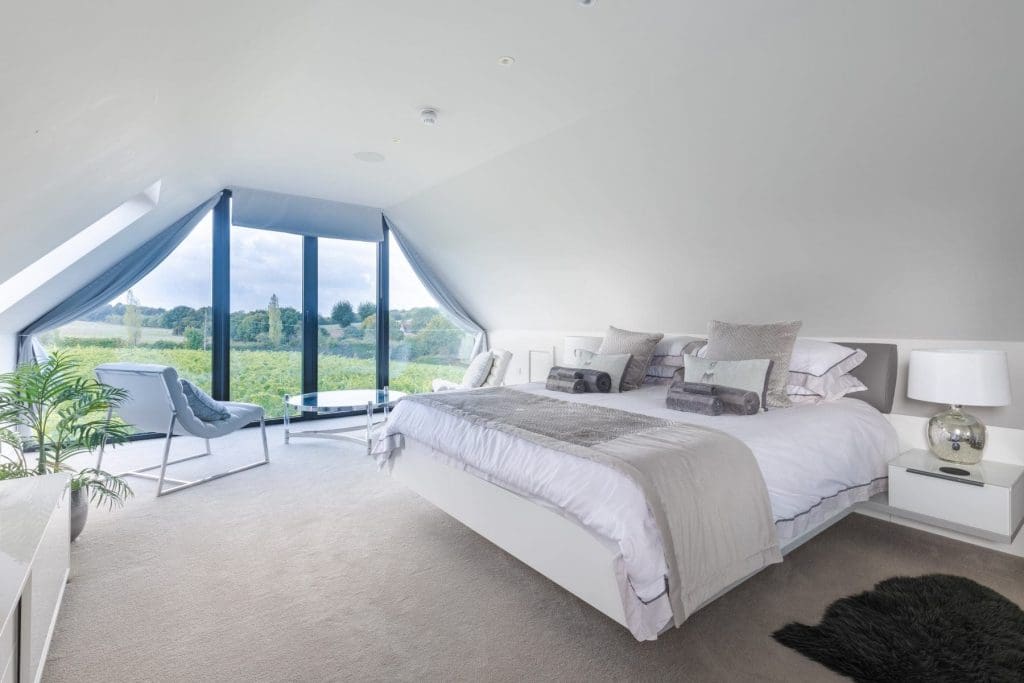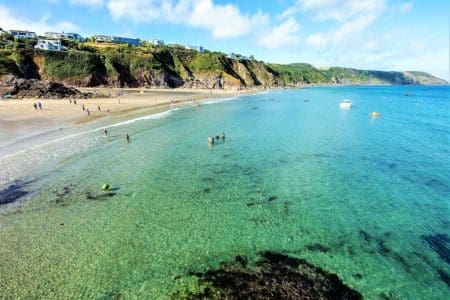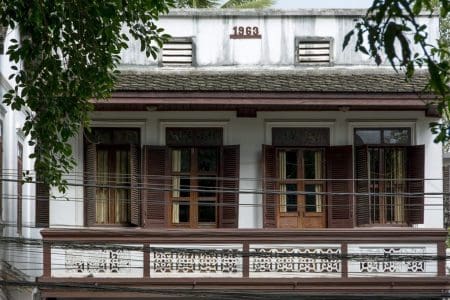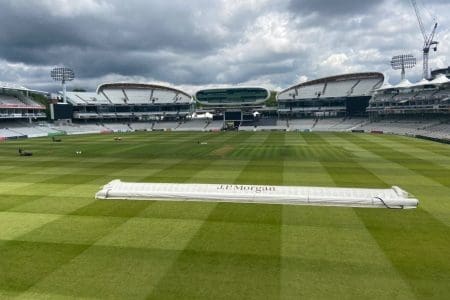Roger Hermiston and Eileen Wise stay at Toppesfield Vineyard in Essex, to enjoy the excellent wine and luxury accommodation.
It was the most ravishing of views. As the late summer sun streamed in through the floor-to-ceiling window of our upstairs bedroom, an abundant vineyard – just ten days away from being harvested – lay right there in front of us, its grapes so close we could almost reach out and touch them. On the horizon, the expansive hills and woods of the landscape of the rolling Colne Valley beckoned.
This lovely setting was the Toppesfield Vineyard in Essex, close to the Suffolk border, where we were staying for two nights in a recently-developed luxury holiday home that once functioned as the estate’s wine tasting centre. Owners Peter and Jane Moore – who live next door in a stunning 14th-century manor house – had made us most welcome, along with their gregarious dog Purdy (a Hungarian Vizsla) and equally sociable cats Fergus (a regal Maine Coon) and Pinot (a beautiful British Blue).
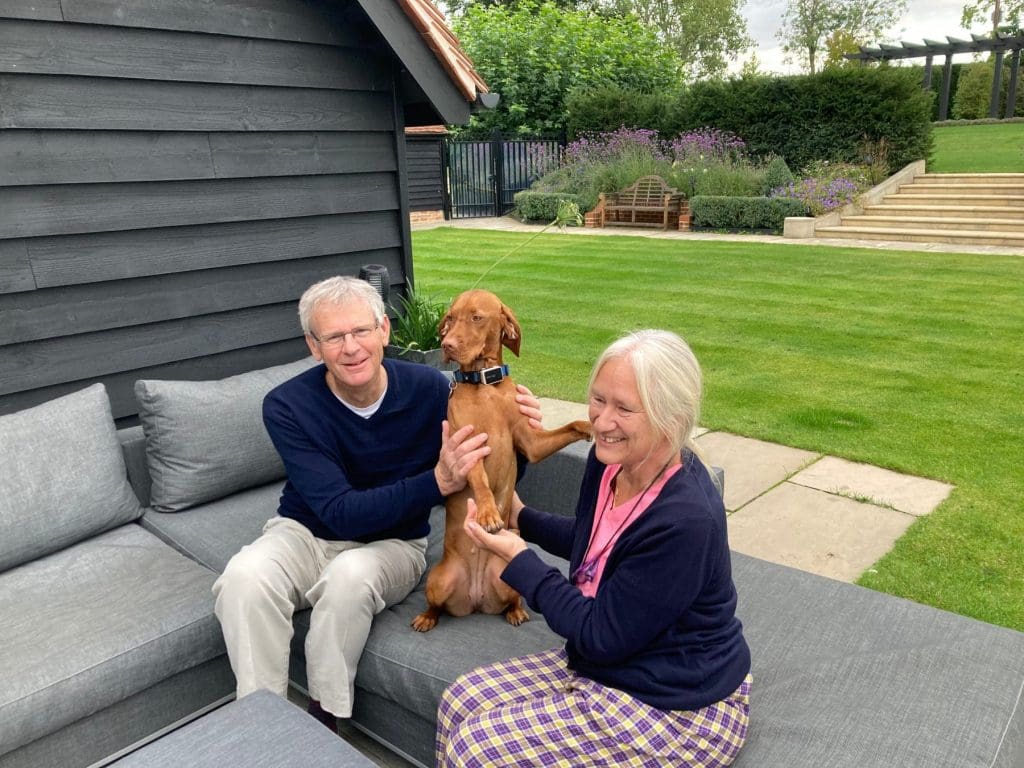
Toppesfield Vineyard
More of our impressive guest house later. But the story of how Peter and Jane came to plant the vineyard around it is a fascinating one, and worth telling first. It begins in the winter of 2011 when the couple had the opportunity to buy some agricultural land around the house.
At that time their busy working lives were based in London – Jane was a partner in a global IT consulting firm, while Peter ran his own technology company servicing the hospitality and corporate catering sector. Peter’s initial thought was that they might turn the land over to cattle or sheep. “Not a chance!” was Jane’s response. “Having had sheep as a child I knew the work involved – treating for maggots and clipping sheep’s hoofs – and I certainly didn’t fancy heading out into the field at 8pm on a wet and windy winter night after a long day in the city.”
Their imagination was then fired by friends who had recently bought a vineyard. The idea of using their sizeable plot of land to plant and develop their very own vineyard dovetailed neatly with Peter and Jane’s joint practical, technological and entrepreneurial skills. There was also an air of romanticism about it because of what had been discovered on their land two centuries earlier.
A Roman Vineyard?
On 28 June 1800, a farm labourer digging a ditch “at the bottom of Red Barnfield in the parish of Toppesfield” made a stunning discovery. He unearthed a skeleton with fragments of a sword lying across his breast; later, excitingly, the analysed remains were deemed to have been those of a Roman centurion. Also buried with him was a metal vase and ceramic bowl, together with several elegant little cups of Samarian (fancy Roman) tableware.
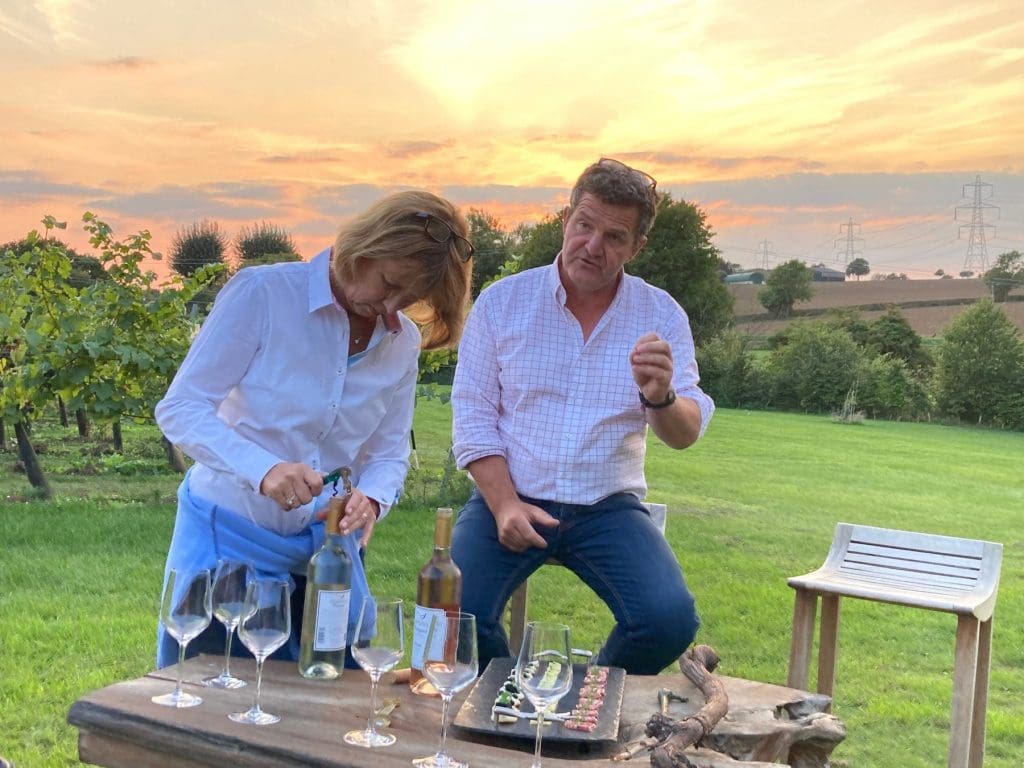
It only fed the lore of an East Anglia brimming with vineyards some 2,000 years ago. Of course, we know for certain that the Romans had a major presence in this part of the world. We are also told that in 278AD Emperor Marcus Aurelius Probus gave the Britons, Gauls and Spaniards permission to cultivate vineyards and produce wine. And while we have no absolute proof of wine growing bountifully in this region in Roman times, the legend remains a powerful one and ever more slivers of evidence emerge.
Novices as they were, Peter and Jane sensibly employed experienced local viticulturist Duncan McNeil to assess the suitability of their land for such a project. His advice was that their clay over chalk soil would work, and that combined with the hilly aspect and the typical East Anglian warmth (increasingly fuelled by climate change) made this a more than promising site. But he advised the couple to “keep it simple” and concentrate on just a couple of grape varieties in order to maximise quality.
So Peter and Jane planted their twelve acres with Bacchus and Pinot Noir Précoce – and since 2016, when their first crop was gathered in, they haven’t looked back. From the Bacchus comes a lovely, dry, crisp fruity white wine, with flavours of gooseberry, nettle and elderflower (‘The English Hedgerow’), while the Pinot Noir produces a dry, pale, Provencal-style rose with hints of English strawberries and citrus.
Harvest day at Toppesfield – nervously and finely judged at almost the last minute – is a great event, a ritual for the ages, with 50 or more villagers coming in to pick the grapes. Then the produce is sent off to the New Hall Wine Estate in Purleigh for pressing, fermentation and the rest of the industrial process. The final choice of the wine – five choices drilled down to a shortlist of two – is largely down to Jane with her more sophisticated palate.
A British Wine Revolution
For much of the 20th century the East Anglian – indeed the British – wine industry was in the hands of amateurs, hobbyists and enthusiasts who, frankly, produced mostly indifferent stuff. But the last twenty years has wrought a revolution in quality and quantity (between 2020 and 2021 three million vines were planted in Britain), there are now around 800 vineyards, and as a country we can stand up and compete with the likes of France and Italy.
Persuading the conservative wine drinkers of the UK to switch allegiance to home-grown varieties has not been easy, but Jane’s experience in the commercial world certainly helped. Hours spent in persuasion at her stall at local supermarkets, farm shops, garden centres have paid off with a loyal regional clientele – Toppesfield supplies 120 of the East of England’s Co-op stores – and increasing direct sales.
Toppesfield Vineyard Wine Tasting and Awards
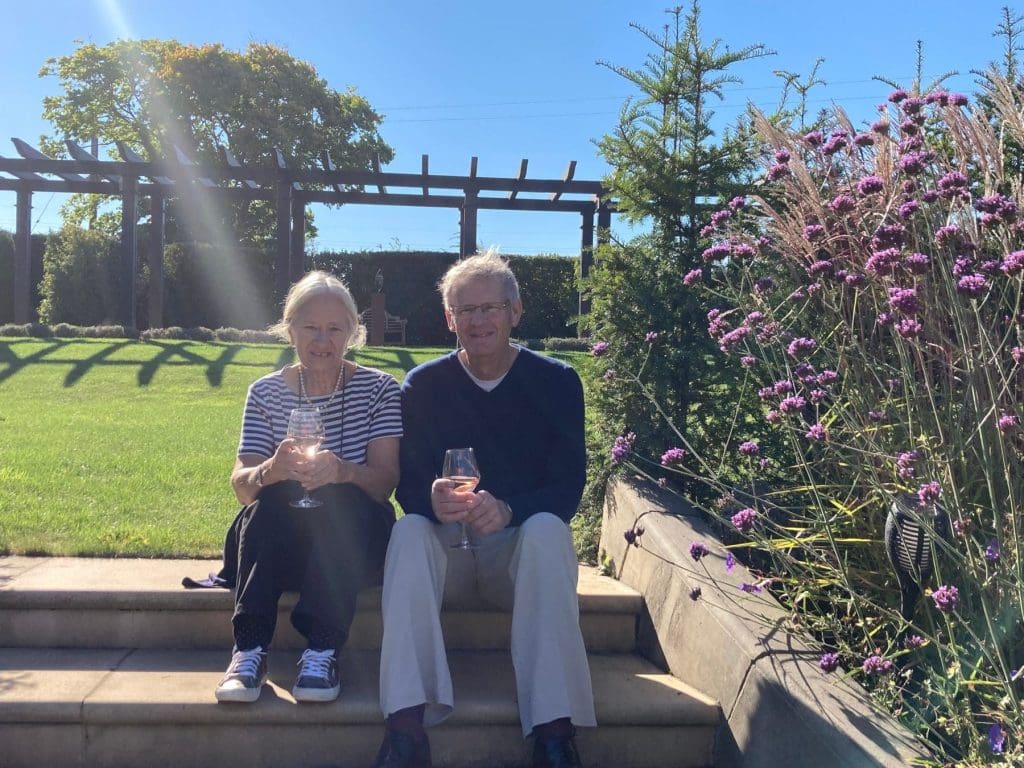
On our first evening, Peter treated us and two of our friends, Ashley and Jacqui, to a fascinating open-air lecture (followed by a tasting) on the techniques of planting and cultivating his vineyard, about the important choice of root stock, how to calculate row width to maximise the sun, and the irrigation and the inversional air required to protect against frost.
The passion with which the couple clearly go about their business has been rewarded with a host of gold, silver and bronzes in the GB Wines awards, the certificates proudly displayed in the guest house. Toppesfield produces 10,000 bottles a year and that figure will rise significantly after the development of another four acres in 2023.
Staying at Toppesfield Vineyard
To live amongst the vines for two days is a delightful experience. To say that the guest house – in the old cliché – has ‘all the mod cons’ would not accurately reflect all its technological aids. Electricity is powered by a small solar farm – discretely shielded by foliage – at the top of the farm. Switching and dimming lights and lowering blinds in the house is done easily enough when you get to know how – but never fear, ‘Alexa’ is there to help should you fail.
The house could comfortably take four – there are two elegant, extremely comfortable bedrooms upstairs with super king-sized beds, plus a huge marbled bathroom you could almost jog around, accommodating a roll-top bath, easy-to-work walk-in shower and spacious wash basins.
The enormous sitting-room downstairs, Scandi-like in its choice of colours (grey, black and white) and furniture, has a long floor-to-length window which looks out onto an immaculately-kept lawn and flower beds, the latter planted so that in every season something new will sprout up. Up the garden steps and another stretch of lawn leads you to an impressive pergola, and beyond that a shaded bench which is a lovely aspect from where to spend an hour reading a novel.
Michael Ayrton
On the walls of the sitting-room are a series of fascinating photographs marking the life and times of the artist Michael Ayrton, who used to live in Peter and Jane’s house next door, ‘Bradfields’, until his premature death at 54 in 1975.
Ayrton was a versatile yet underrated (by the public, not by his contemporary artists) painter, drawer and sculptor. In particular, he was drawn to Greek myths, not least by the story of the Minotaur, the fearsome half-man, half-bull creature.
In all Ayrton created no less than 90 works inspired by the Minotaur – you can still view his most famous sculpture of the beast at London Wall Place, in the heart of the City of London. On the wall of the guest house is a photograph of it, capturing the alienation and pain of a fantastical creature caught between the divine, animal and human worlds.
We didn’t avail ourselves of the enticing hot-tub on the veranda, nor did we quite have the energy this time for the tennis court which is also available for guests but instead enjoyed the a rare treat of sitting quietly and peacefully reading our books.
With the comfort of the house and garden, the availability of excellent farm walks near and far, and the sporting option, Toppesfield Vineyard has more than enough to keep you occupied. But if you wish to venture out into this attractive part of the Essex countryside there is much of interest right on your doorstep.
Finchingfield
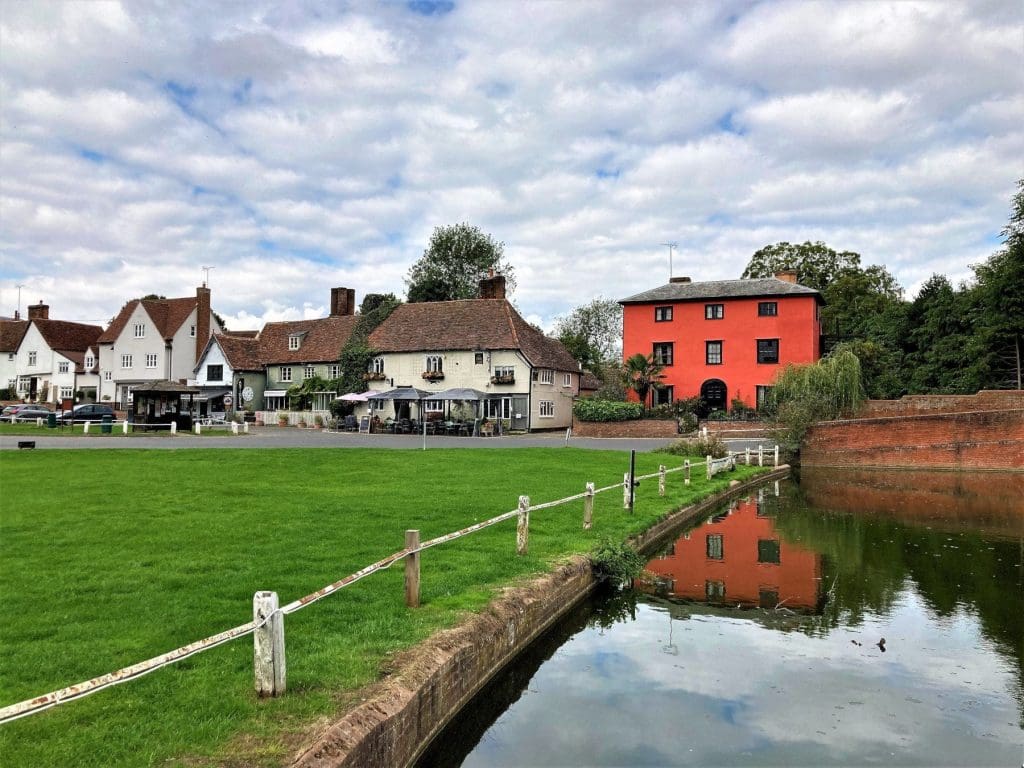
Castle Hedingham would be the number one option, surely, for those who like their history and their stately homes. It’s the most iconic site in the county, with its magnificently preserved Norman keep. But we had been before so instead, we made tracks to the picture-perfect village of Finchingfield, in its amphitheatre-like setting, for lunch and a stroll.
Life is full of curious coincidences. Roger was in the middle of reading Robert Harris’s gripping new thriller ‘Act of Oblivion’, about a couple of Puritan ‘regicides’ (who had signed King Charles I’s death warrant) on the run from Charles II’s henchman in New England, America in the 1660s.
In the 1640s thousands of Puritans from East Anglia did make the same journey that Harris’s fictional characters took, and we had barely got past the doors of Finchingfield’s splendid Norman church, St John the Baptist, when there in front of us was a bronze plaque commemorating one of them! ‘In memory of Daniel Shed’, it read, ‘Baptized at Finchingfield, founder of New England about 1640. His descendants in America have restored in this church the ancient Angelus bell to the glory of God’.
The church – whose spire was blown down in Cromwell’s time – contained other historical gems, among them the beautifully constructed tomb chest and brasses of Sir John Berners and his wife Elizabeth, in the chapel that bore the knight’s name. You had to peer closely but near the head of Sir John was inscribed the figure of a little monkey, in memory of the animal whose screeches saved the life of Sir John’s son when his house caught fire and was destroyed.
Leaving the church a walk on the footpath took us past Finchingfield’s back gardens and threw up an extraordinary sight in one of them – that of a fully intact post mill, dating back to 1756, a superb example of the millwright’s craft of that time.
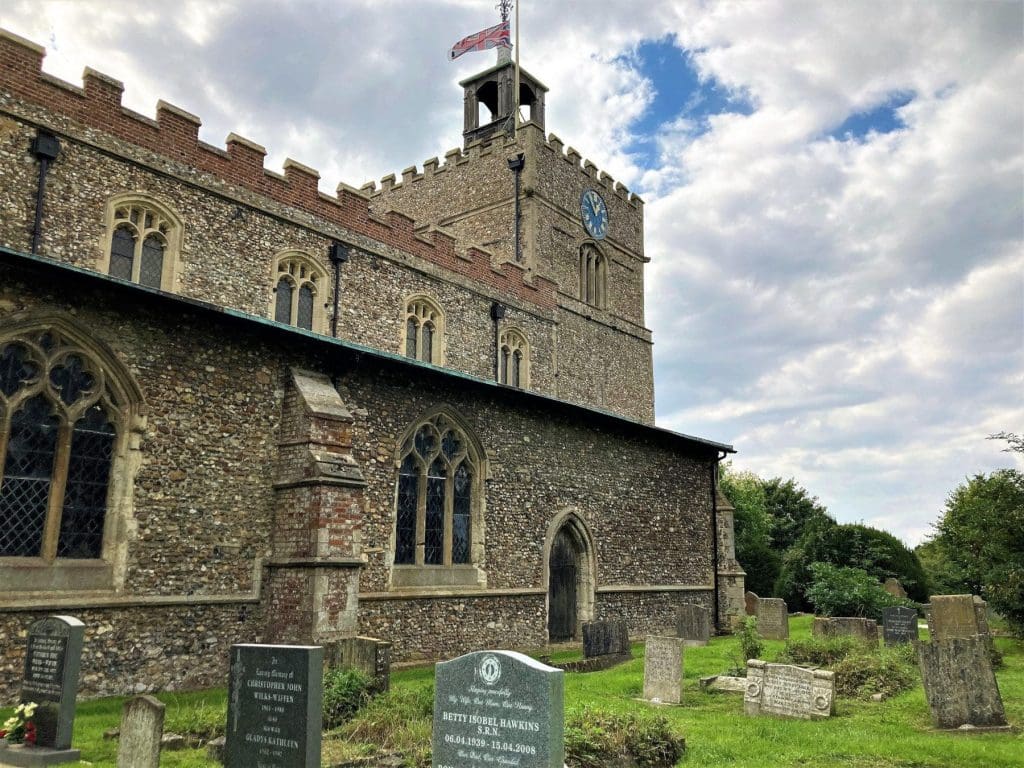
Dining at Toppesfield and the White Hart
The Toppesfield house has an excellent kitchen so the temptation is to rustle up something simple – or order a takeaway – and settle back with a glass of Bacchus in front of the enormous TV screen, the biggest we had encountered outside of a cinema. So we had our own night at the movies, enjoying two episodes of The Crown on Netflix – an apposite choice, it seemed, just days after the Queen’s death.
But of course, there are some quality pubs and restaurants close by, and for the other of our two nights, we headed for the White Hart at Great Yeldham. This characterful 15th-century coaching inn, complete with traditional wooden beams and open fireplaces, has friendly and attentive staff and, just as importantly, a menu full of enticing dishes. Goats cheese croquettes, roasted duck breast with bacon and cabbage, and strawberry cheesecake was just the job at the end of a busy, entertaining day.
The following morning we bade farewell to our hosts – and their friendly animals – who had looked after us so well and wended our way home. We live just a 25-minute drive from Toppesfield, but for those two days at the vineyard, we had been transported into a delightful other world.
Toppesfield Vineyard
For more information about possibly the best vineyard in Essex, as well as Toppesfield Vineyard accommodation, click here.
